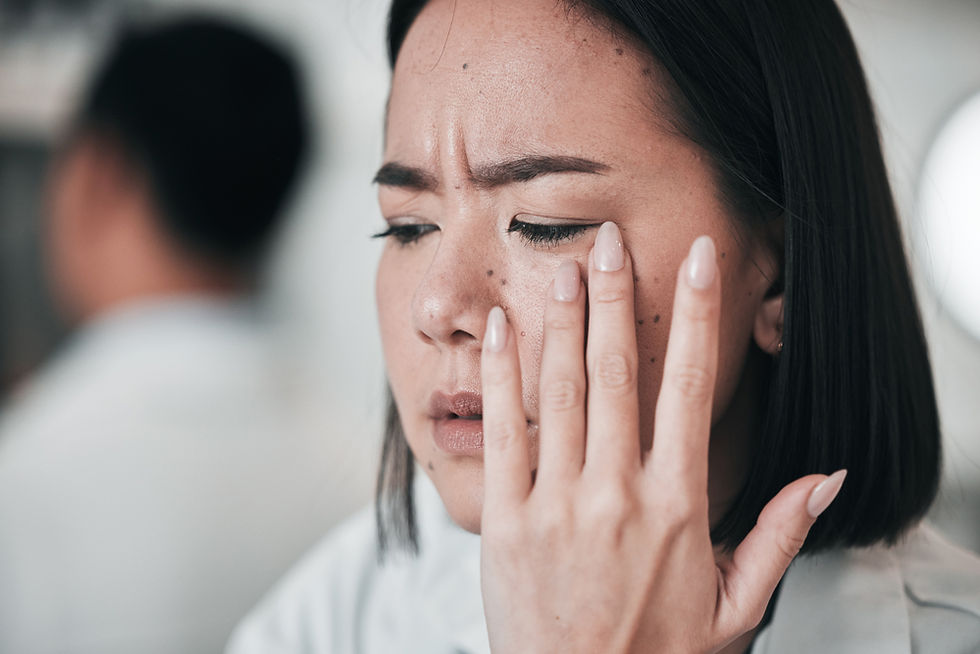Munjaro, Ozempic, and Diabetic Retinopathy
- Sharon Heng
- Aug 18
- 3 min read
✅ Medically reviewed by Dr Sharon Heng

Diabetic retinopathy is one of the most serious complications of diabetes and a leading cause of vision loss in adults. It occurs when persistently high blood sugar levels damage the tiny blood vessels in the retina—the light-sensitive tissue at the back of the eye. Over time, this can lead to vision impairment, blurry vision, and even complete blindness if left unmanaged.
With the global rise in diabetes cases, especially Type 2 diabetes, the number of people affected by diabetic retinopathy continues to climb. Treatment and prevention depend largely on controlling blood sugar, blood pressure, and cholesterol. This is where new medications like Munjaro and Ozempic come into the spotlight—not just for managing diabetes but also for their potential effects on diabetic eye disease.
What Are Munjaro and Ozempic?
Munjaro (tirzepatide) and Ozempic (semaglutide) are newer classes of injectable medications used to treat Type 2 diabetes. Both drugs work by mimicking the hormones that regulate blood sugar and appetite, helping patients achieve better glycemic control while often aiding in weight loss. They belong to a class of medications known as GLP-1 receptor agonists, although Munjaro also targets another receptor called GIP.
These medications are typically prescribed for individuals who haven’t achieved adequate blood sugar control through oral medications or lifestyle changes alone. Over the past few years, they’ve gained popularity not only for their effectiveness in lowering blood sugar but also for their broader health benefits—including cardiovascular protection.
Can These Medications Affect Diabetic Retinopathy?
The relationship between GLP-1 drugs like Ozempic or dual agonists like Munjaro and diabetic retinopathy is complex. On one hand, better blood sugar control reduces the risk of microvascular complications, including retinopathy. However, some early clinical trials, particularly with Ozempic, suggested that rapid improvements in blood glucose could potentially worsen diabetic eye disease in certain patients.
This paradoxical reaction may be due to the speed at which glucose levels drop rather than the drug itself. For example, individuals with longstanding poorly controlled diabetes may experience a temporary worsening of diabetic retinopathy when blood sugar improves too quickly. This is why healthcare providers often recommend gradual glycemic control to avoid retinal stress.
Recent research, however, has begun to paint a more nuanced picture. Emerging data suggests that with proper patient selection and monitoring, these medications do not inherently cause retinopathy and may even contribute to long-term eye health by improving metabolic profiles. Still, awareness and regular screening remain essential.
The Importance of Monitoring and Eye Care
If you’re starting on Munjaro or Ozempic and already have signs of diabetic retinopathy, close collaboration between your primary care physician, endocrinologist, and eye specialist is crucial. Baseline retinal screening should be conducted before initiating therapy, followed by regular monitoring to catch any changes early.
Patients should not skip their annual dilated eye exams, even if their vision seems fine. Retinopathy often develops silently, with symptoms only appearing when damage is advanced. Timely detection allows for interventions like laser treatment or injections that can preserve sight.
In addition to blood sugar control, managing hypertension and cholesterol levels can significantly slow the progression of diabetic retinopathy. Munjaro and Ozempic may assist here too, as they are associated with modest reductions in blood pressure and improvements in lipid profiles.
Weighing the Benefits and Risks
For many patients, the benefits of Munjaro and Ozempic outweigh the potential risks. Improved glycemic control not only lowers the risk of retinopathy but also reduces the likelihood of heart disease, kidney damage, and neuropathy. Moreover, the added benefit of weight loss can have a positive impact on overall diabetes management.
However, these medications are not one-size-fits-all. Patients with existing eye disease need careful assessment and tailored treatment plans. It’s also important to be transparent with your healthcare provider about any vision changes, even minor ones, after starting treatment.
Conclusion
Munjaro and Ozempic represent a significant advancement in the management of Type 2 diabetes. While some concerns have been raised about their potential effects on diabetic retinopathy, the consensus among experts is that when used appropriately, they are powerful tools for preventing complications, including those affecting the eyes.
Ongoing monitoring, communication with your care team, and consistent eye exams remain the cornerstone of diabetic retinopathy prevention. As new evidence emerges, these medications may not only help control blood sugar but also support long-term vision health for millions of patients.




Comments